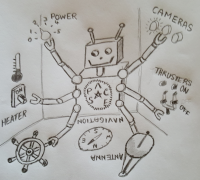
The Accelerating the Use of Autonomy on Robotic Space Missions Workshop will focus on the following questions:
-
What are the impediments to making more use of autonomy on robotic space missions?
-
Which of those impediments apply to which kinds of space missions?
-
In order to overcome those impediments,
-
What has been done in the past that has proven successful?
-
What approaches show promise, and what needs to be done to prove their worth?
-
What further ideas can be proposed?
-
Those interested in participating are encouraged to suggest answers to any of the above questions and email them in advance to Martin.S.Feather@jpl.nasa.gov.
Answers are also welcomed from those not planning to participate in the workshop.
We provide a detailed list of potential impediments and ways they might be addressed below to give participants an idea of where the discussion may lead.
Agenda
A detailed agenda and background material is available here.
Registration
This workshop will take place within the 2021 SMC-IT conference online - July 26-30, 2021. This workshop will take place as three two-hour sessions on separate days.
- Monday 26th July 1pm – 3pm PDT
- Thursday 29th July 1pm – 3pm PDT
- Friday 30th July 1pm – 3pm PDT
Conference registration is required to attend this workshop (such registration covers the whole conference as well as this workshop) – see SMC-IT .
Organisers
The Accelerating the Use of Autonomy on Robotic Space Missions Workshop is organised by:
Potential Impediments
To start your thinking, here is a draft list of possible impediments. Are there more? To which kinds of missions do they apply? How can they be addressed?
-
Verification and Validation challenges:
-
a. Testing autonomy when it is to function in a large variety of situations
-
b. Assessing risk when autonomy in involved
-
c. Developing simulation environments of adequate fidelity
-
d. Reviewing / inspecting autonomy software
-
e. Unknown what coding standards are appropriate for autonomy software
-
-
Engineering gaps – lack of knowledge of:
-
a. The appropriate development process (waterfall, spiral, agile, …)
-
b. How to estimate the cost and schedule of developing an autonomy capability
-
c. What metrics to use to track the progress of autonomy development
-
d. How to decompose requirements to the point where they can be implemented
-
e. How to develop models for model-based autonomy
-
f. Autonomy isn’t compatible (or we don’t know how to make it compatible) with the traditional parts of spacecraft software
-
g. How hard it will be to debug autonomy software
-
-
Concerns
-
a. Operations teams will not know how to control autonomy
-
b. Operations teams will not know why autonomy behaved the way it did
-
c. Autonomy will achieve its goals in an unintended, unacceptable manner
-
d. Autonomy cannot be relied upon to take the correct actions
-
e. Some forms of autonomy have very varied and unpredictable runtime performance and/or resource usage
-
f. Autonomy developers will be lured away by terrestrial autonomy applications
-
-
Infusion barriers
-
a. Proposers of missions avoid considering autonomy because they don’t understand it
-
b. Reviewers of missions that use autonomy don’t understand it, so rate it as too risky
-
c. There is a lack of metrics to support the argument that autonomy is cost effective
-
d. Small missions cannot afford autonomy
-
e. Large missions will not accept the risk of using autonomy
-
f. Autonomy is made to be too mission-specific, meaning it will not be reusable
-
g. Autonomy fails to advance from research into practice
-
h. Autonomy is hard to describe, so does not attract the funding it needs to mature
-
i. Space missions are too infrequent to allow for the continuous advancement of autonomy, leading to talent drain
-
j. Autonomy is not developed in-house because of the expectation that it can be bought from elsewhere
-
k. Autonomy is never the first priority for research and development funding
-
And here are a few examples of how some of those impediments might be addressed – a goal of the workshop is provide improvements to, and many more of, these answers!
1 a) Guide testing towards scenarios where the system is getting closer to the edge of failure
1 a) Use formal methods to check the correctness of decision algorithms
2 b) Gather together from as many places as possible information on the effort it has taken to develop kinds of autonomy
3 a) Involve operations teams from the start of an autonomy development
3 c) Direct autonomy (e.g., an autonomous planner) to exclude common solutions to see what unusual solutions it discovers
4 f) Insist that autonomy developments be design and made to be reusable
4 i) Collaborate with other areas where autonomy can be infused and operated more frequently and more quickly, e.g., underwater vehicles, maritime automation